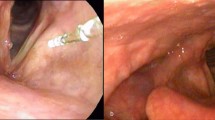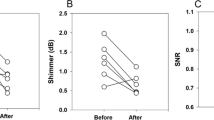Abstract
Background
Removal of Reinke’s edema may result in moderate to large-sized mucosal defect on the vocal fold, which heals by secondary intention. Microsuturing this defect may lead to primary wound healing with fastened recovery and less scar, but costs extra time and effort. Exploring methods that can shorten microsuture time is helpful for the wider application of this technology.
Study design
Retrospective.
Methods
57 patients with Reinke’s edema, who were admitted from November 2010 to June 2018, were enrolled as research subjects for the retrospective analysis. 27 patients were the knot pusher group (from November 2010 to March 2015), and 30 patients were the two-handed tying group (from April 2015 to June 2018). Evaluation indicators include the number of knots, the average time for suturing and tying the knot for each patient, and the occurrence of complications, subjective and objective voice assessments.
Results
All patients underwent successful operation. The average time for making knots in the knot pusher group and two-handed tying group was 668.40 ± 173.73 s and 328.73 ± 121.0 s, respectively, and there was a statistically significant difference between the two groups (p < 0.001). No significant difference was noted in the mucosal avulsion, overall incidence of complications between the groups, and no significant difference was found between the two groups in terms of the preoperative and 3-month postoperative subjective and objective indicators.
Conclusion
Microsuturing of Reinke’s edema microflaps using the two-handed tying technique can achieve the similar effect with the knot pusher method, and save operation time while the surgeon is well trained.
Level of evidence
4.




Similar content being viewed by others
Change history
07 June 2019
In the original publication, the patient number was incorrectly published under the “Methods” heading in the abstract section. The incorrect sentence reads as “55 patients with Reinke’s edema, who were admitted from November 2010 to June 2018, were enrolled as research subjects for the retrospective analysis.”
References
Tan M, Bryson PC, Pitts C, Woo P, Benninger MS (2017) Clinical grading of Reinke's edema. Laryngoscope 127(10):2310–2313
Marcotullio D, Magliulo G, Pezone T (2002) Reinke's edema and risk factors: clinical and histopathologic aspects. Am J Otolaryngol 23(2):81–84
Salmen T, Ermakova T, Schindler A, Ko SR, Goktas O, Gross M, Nawka T, Caffier PP (2018) Efficacy of microsurgery in Reinke's oedema evaluated by traditional voice assessment integrated with the Vocal Extent Measure (VEM). Acta Otorhinolaryngol Ital 38(3):194–203
Yilmaz T, Sozen T (2012) Microsuture after benign vocal fold lesion removal: a randomized trial. Am J Otolaryngol 33(6):702–707
Myer CT, Johnson CM, Postma GN, Weinberger PM (2015) Comparison of tensile strength of fibrin glue and suture in microflap closure. Laryngoscope 125(1):167–170
Maunsell RC, de Freitas LL, Altemani A, Crespo AN (2013) Histologic comparison of vocal fold microflap healing with sutures and glue. Laryngoscope 123(7):1709–1716
Yonekawa H (1988) A clinical study of Reinke's edema. Auris Nasus Larynx 15(1):57–78
Martins R, Tavares E, Pessin A (2017) Are vocal alterations caused by smoking in Reinke's edema in women entirely reversible after microsurgery and smoking cessation? J Voice 31(3):311–380
Kamargiannis N, Gouveris H, Katsinelos P, Katotomichelakis M, Riga M, Beltsis A, Danielides V (2011) Chronic pharyngitis is associated with severe acidic laryngopharyngeal reflux in patients with Reinke's edema. Ann Otol Rhinol Laryngol 120(11):722–726
Koszewski IJ, Hoffman MR, Young WG, Lai YT, Dailey SH (2015) Office-based photoangiolytic laser treatment of Reinke's edema: safety and voice outcomes. Otolaryngol Head Neck Surg 152(6):1075–1081
Pitman MJ, Lebowitz-Cooper A, Iacob C, Tan M (2012) Effect of the 532 nm pulsed KTP laser in the treatment of Reinke's edema. Laryngoscope 122(12):2786–2792
Tan NC, Pittore B, Puxeddu R (2010) The “M” shaped microflap for treatment of complex Reinke's space oedema of the vocal cords. Acta Otorhinolaryngol Ital 30(5):259–263
Honda K, Haji T, Maruyama H (2010) Functional results of Reinke's edema surgery using a microdebrider. Ann Otol Rhinol Laryngol 119(1):32–36
Dursun G, Ozgursoy OB, Kemal O, Coruh I (2007) 1-year follow-up results of combined use of CO2 laser and cold instrumentation for Reinke's edema surgery in professional voice users. Eur Arch Otorhinolaryngol 264(9):1027–1032
Acknowledgements
This study was supported by Natural Science Foundation of Guangdong Province, China (2018A030313691).
Author information
Authors and Affiliations
Corresponding author
Ethics declarations
Conflict of interest
The authors declared that they have no conflicts of interest to this work.
Additional information
Publisher's Note
Springer Nature remains neutral with regard to jurisdictional claims in published maps and institutional affiliations.
The original version of this article was revised: In the original publication patient number under the 'Methods' heading in the abstract section was incorrectly published as 55. This has been corrected as 57 in the original publication.
Electronic supplementary material
Below is the link to the electronic supplementary material.
Rights and permissions
About this article
Cite this article
Liang, F., Chen, R., Lin, P. et al. Two-handed tying technique in vocal fold mucosa microsuture for the treatment of Reinke’s edema. Eur Arch Otorhinolaryngol 276, 2015–2022 (2019). https://doi.org/10.1007/s00405-019-05480-y
Received:
Accepted:
Published:
Issue Date:
DOI: https://doi.org/10.1007/s00405-019-05480-y




